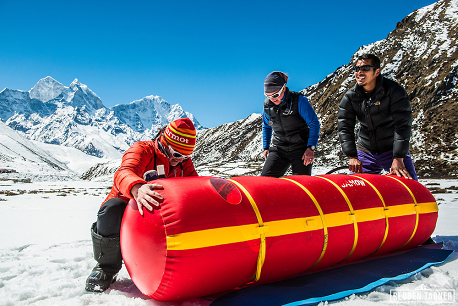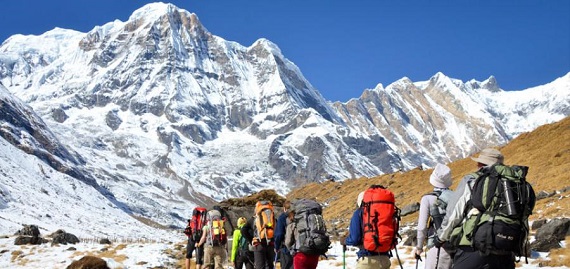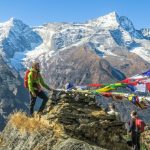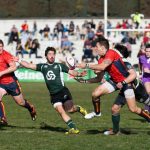JS Travel Insurance – Top 10 Tips on Avoiding Altitude Sickness (AMS)
GET A QUOTE
Drink lots of Water
Altitude Sickness can be caused by a higher rate of water vapour being lost from the lungs as you ascend to higher altitudes and can also contribute to dehydration, so it’s essential to drink lots of water, even if you have to pay for it.
Safe drinking water stations are available along many treks (for a fee), or you can bring your water purifier or chlorination/iodine tablets.
Trekkers are discouraged from buying bottled water along the trek due to its environmental impact and lack of rubbish disposal systems.
You should drink 3 litres of water a day whilst Trekking.
Plan your trip
One of the best ways to prevent altitude sickness from occurring is to establish a sensible itinerary before setting out. While you might be accustomed to Trekking a certain number of kilometres each day, this will most likely need to be reduced when Trekking at high altitudes, no matter how fit you think you are.
It’s recommended that you don’t climb more than 300 metres (1,000 feet) a day above 3,000 metres (10,000 feet) altitudes.
But if this isn’t possible due to the terrain or accommodation availability, schedule a few rest days to allow your body to acclimatize after a rapid ascent. Always have a flexible itinerary with an extra day or two built into the schedule, just in case symptoms of altitude sickness start presenting themselves.
Travellers often push themselves to meet flight bookings or onward travel plans while putting their bodies at severe risk and potentially fatal consequences.
Go at a Slow Pace to avoid Altitude Sickness.
Even physically fit, you should stroll below your optimum pace.
The rate at which you ascend, the altitude you are Trekking, and your level of physical activity all contribute to altitude sickness.
This is why most high-altitude treks include acclimatization days (roughly every third day), where you rest and allow your body to adjust to the reduced oxygen in the air.
Climb Steep, Sleep Low
Avoid drinking alcohol or taking sleeping pills whilst Trekking, and ensure you drink plenty of water. The trekker’s mantra of “climb high and sleep low” should also be followed, meaning if you climb more than 300 metres (1,000 feet) daily, come back down and sleep at a lower altitude. Never trek alone, and always follow the advice of your guide.
If symptoms of HAPE (High Altitude Pulmonary Edema or HACE (High Altitude Cerebral Edema) start presenting themselves, begin your descent immediately and never continue ascending to a higher altitude, even if it’s just to spend the night.
Dexamethasone may assist in facilitating the descent but will only help improve the symptoms without improving the body’s acclimatisation. Nifedipine may be used to lower pressure in the pulmonary blood vessels of those experiencing HAPE and help decrease fluid in the lungs, or Sildenafil (viagra) is another option.
If descending isn’t possible or you don’t see rapid improvement following medical treatment, evacuation by helicopter may be essential.
Do ‘Tandem Gait Test
A good test for HACE is the “Tandem Gait Test”, with the person walking heel to toe in a straight line. If they cannot remain in a straight line, then they may be experiencing HACE.
Bring a Gamow Bag
Administering oxygen can also be very effective in reducing the effects of acute altitude sickness, as can a Gamow Bag.
Once inflated, this portable bag creates a high-pressure environment where a person with severe symptoms can be placed and pumped with air. The pressure created inside increases the oxygen tension, helping to improve symptoms in an acute crisis before the person can descend or be evacuated by helicopter.
Gamow bags are available at the Manang and Pheriche Himalayan Rescue Association Aid Posts and Kunde Hospital and for rent in Kathmandu for those trekking to remote regions. Some Trekking Companies also carry their own, so checking before booking is a good idea.

Take Lake Louise Scoring System
Self Assessment on whether you have AMS.
A good indication of whether you are experiencing AMS is the Lake Louise Scoring System, which uses an assessment questionnaire and scorecard to determine whether you have no AMS, mild AMS or severe AMS. It should be done twice daily in conjunction with pulse oximeter readings, with scores given for difficulty sleeping, headaches, gastrointestinal symptoms (nausea, appetite, vomiting), dizziness, fatigue and weakness.
Take Diamox Tablets
Diamox (acetazolamide) can be taken to prevent the onset of altitude sickness and works to block an enzyme in the kidney that makes the blood acidic.
This sends a message to the brain to breathe more, helping to enhance the body’s physiological response to an increase in altitude.
Diamox should be taken the day before ascending to 3,000 metres (10,000 feet) and continued twice daily to your highest ascent.
For those allergic to sulfa drugs, talk to your doctor about getting a prescription for dexamethasone. This steroid can reduce symptoms for short periods when abrupt ascents are unavoidable.
Simulate Altitude Training Before you go.
You can visit an altitude simulator centre in the UK, such as Basingstoke’s Sporting Edge (www.trainingwithaltitude.co.uk) or London’s Altitude Centre (www.altitudecentre.com), where you can train in the conditions you are likely to experience in Nepal.
It will help improve your oxygen efficiency, with individual consultations and group running and cycling classes available in their replicated environmental chambers.
How fit should you be before you go?
You should be in the best physical shape possible before embarking on your trek and preferably do some Trekking at altitude a few months before heading to Nepal to help your body acclimatize.
If you don’t have mountains near where you live, try to get out for a few multi-day hikes to help your body become accustomed to the routine of Trekking over consecutive days.
Make sure you get a proper Travel Insurance policy; call us for a quote at 0800 043 0020 or 01273 092 757
www.ultimatekilimanjaro.com/Lake-Louise-AMS-Questionnaire.htm
www.trainingwithaltitude.co.uk/
www.switchbacktravel.com/nepal/altitude-sickness
www.en.wikipedia.org/wiki/Altitude_sickness

/Gold/Gold%20Trusted%20Service%20Award%20-%20Badge%20-%201x1.png?width=481&name=Gold%20Trusted%20Service%20Award%20-%20Badge%20-%201x1.png)








Leave a Reply